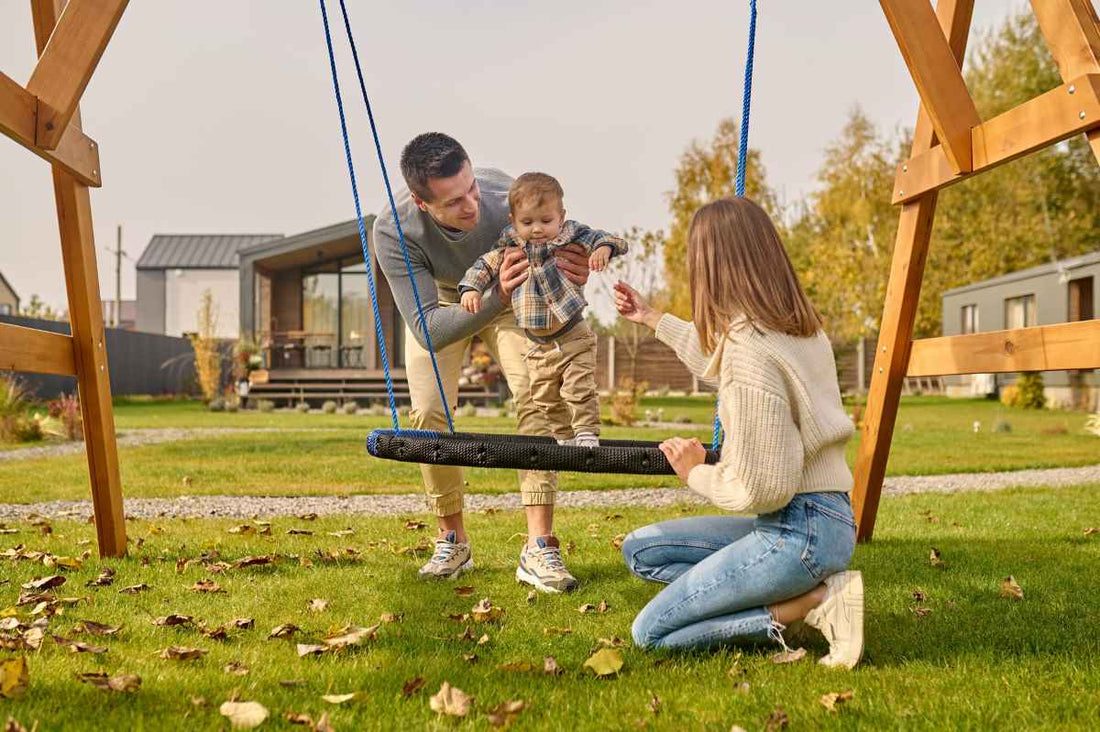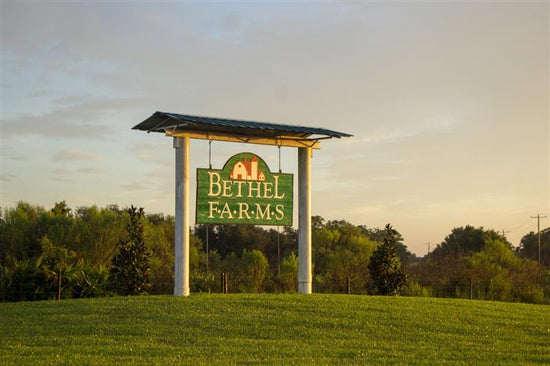
How to Maintain a Lawn That's Fun & Safe for Kids
Jamie TedderSpending time outdoors with family is one of life’s simple joys. Fresh air, open spaces, and the ability to engage with nature create cherished childhood memories. However, creating fun and safe environments for kids is a top priority for parents. A well-maintained lawn provides the perfect setting for outdoor play.
Sod is an excellent option for a safe and healthy lawn for children. Sod provides immediate coverage, a dense turf that cushions fall, and faster establishment for high-traffic areas. Whether starting a new lawn or repairing significant damage, sod offers durability and resilience.
In this guide, we’ll explore how to maintain a kid-friendly lawn by selecting the right grass, following proper maintenance practices, and practicing safety measures to create the ideal play space.
Why Sod Is the Best Choice for a Kid-Friendly Lawn
More than 213,000 children are treated in US emergency rooms annually due to playground-related injuries. The most common injuries include broken bones, bruises, and sprains, with many occurring when children fall from equipment onto hard surfaces.
A properly maintained lawn with sod helps minimize the impact of falls, reducing injury risks compared to surfaces like concrete, gravel, or compacted dirt. A thick, lush grass covering provides a natural cushion, making playtime safer. Here’s why sod is an ideal solution for a kid-friendly lawn:
Immediate Coverage & Erosion Control
Sod provides instant ground coverage. It addresses bare areas, reducing soil erosion and minimizing dust and mud, which can create slipping hazards. This makes it especially useful in high-traffic areas where children play frequently.
Durability & Recovery
Quality sod varieties, such as bermudagrass, are known for their ability to withstand heavy foot traffic. These grasses recover quickly from wear and tear, making them ideal for active households with kids and pets.
Fewer Weeds & Pests
A thick sod lawn naturally suppresses weed growth, reducing reliance on herbicides. Additionally, well-maintained grass deters certain pests, creating a healthier play environment for children. By reducing bare soil where weeds and insects thrive, sod helps maintain a cleaner, safer space for your kids to explore freely.
Better Safety & Comfort
Soft, dense grass offers better impact absorption than hard surfaces, reducing the severity of falls. A well-maintained lawn also minimizes trip hazards such as uneven ground. Plus, its cushioning effect makes playtime more comfortable, encouraging kids to stay active outdoors.
Faster Establishment
Sod develops a strong root system in as little as a few weeks, allowing you to enjoy your outdoor space sooner. This faster establishment results in more resilient grass that can better withstand heavy foot traffic, drought, and other challenging conditions, ensuring long-term durability.

Choosing the Right Grass for a Kid-Friendly Lawn
Selecting the best grass type for a kid-friendly lawn depends on climate, sun exposure, foot traffic levels, and maintenance preferences. Warm-season grasses like bermudagrass and zoysiagrass are excellent choices due to their durability and resilience.
Bermudagrass: The Durable and Resilient Option
Bermudagrass is highly durable and recovers quickly, making it ideal for lawns that experience heavy play. Its fine-bladed texture provides a soft surface for children while maintaining excellent drought resistance. This grass thrives in full sun and warm climates, making it an excellent option for Florida lawns.
Zoysiagrass: Soft and Wear-Resistant
Zoysiagrass is another excellent option for a family-friendly lawn. It features a soft texture, good shade tolerance, and exceptional wear resistance. Zoysiagrass forms a thick, dense turf that helps prevent weeds and provides a comfortable surface for kids to play on. Its slower growth rate means less frequent mowing, making maintenance more manageable for busy parents.
Sod Installation and Lawn Maintenance Tips to Keep It Kid-Friendly
Installing sod is the first step toward creating a safe and beautiful lawn, but proper preparation and maintenance are essential for lasting success. Whether establishing a new lawn or repairing damaged areas, sod offers an efficient way to achieve a uniform, healthy green cover. For new installations, start by clearing debris, leveling the ground, and optionally testing the soil pH to create an optimal growing environment. When repairing a lawn, remove dead or damaged grass by cutting out affected areas with a shovel or sod cutter, then loosen the soil to improve root contact before laying fresh sod.
When laying sod, stagger the seams in a brick-like pattern to prevent gaps and ensure even coverage. Press each piece firmly for good soil contact, then water thoroughly to encourage root development. For seamless integration with existing grass, keep the sod consistently moist during the first few weeks. Avoid foot traffic for at least two to three weeks to allow roots to take hold and prevent uneven settling.
Ongoing maintenance is key to preserving lawn health. Mow at the recommended height to encourage thick growth, water deeply but infrequently to develop strong roots, and fertilize as needed for optimal health.
Routine Lawn Care for a Safe Play Environment
Mowing: Maintain an ideal grass height of 2–3 inches to encourage denser growth, keeping the lawn durable and resilient to foot traffic. Avoid cutting more than one-third of the grass blade at a time to prevent stress and promote healthier growth.
Watering: Water deeply but infrequently—about 1 to 2 times a week, applying 1 to 1.5 inches of water—for most warm-season grasses. Early morning watering is best, as it reduces evaporation and helps prevent fungal diseases.
Aeration & Dethatching: Aerate the lawn annually to alleviate soil compaction, improving water and nutrient absorption. Additionally, dethatching as needed helps remove excess organic buildup, preventing suffocation and promoting strong, healthy turf growth.
Fertilization: Apply fertilizer during the active growing season to provide essential nutrients while avoiding excessive fertilization, which can lead to overgrowth and increased disease susceptibility. Use slow-release fertilizers to support steady growth and minimize runoff.
Weed & Pest Management: A thick, well-maintained lawn naturally suppresses weeds, but additional preventive measures help keep them under control. Use mulch to block weed growth, hand-pull weeds before they spread, and encourage beneficial insects like ladybugs to manage pests. Planting pest-repellent species, such as marigolds and mint, can also deter unwanted insects naturally.
Rotating Play Areas: Prevent excessive wear on one spot by designating and rotating play zones periodically. This allows overused areas to recover while maintaining a lush and even lawn. Consider using stepping stones or mulch paths in high-traffic areas to minimize lawn damage.
Creating a Safe Outdoor Play Environment
Child-Proofing Lawn Equipment & Chemicals: Always store fertilizers, pesticides, and gardening tools in locked cabinets or high shelves, away from children's reach. Even organic products can be harmful if ingested, so clearly label all lawn care supplies and keep them in a secure area. Additionally, teach children not to play near storage sheds or areas where equipment is used.
Softening Play Areas: Installing sod around swing sets, slides, and other play structures provides a soft, natural cushion for falls, reducing injury risk. Regularly inspect these areas to ensure sod remains intact and soil erosion is minimal.
Reducing Lawn Hazards: Walk the lawn regularly to remove potential dangers like sharp rocks, fallen branches, and uneven surfaces that could cause trips or injuries. Fill in holes left by pets or burrowing animals to prevent twisted ankles. Be mindful of toxic plants, removing any that could be harmful to children or pets.
Pet Waste Management: Designate specific pet relief areas away from children’s play zones to maintain a clean and hygienic lawn. Promptly remove pet waste to prevent the spread of bacteria and odors, and rinse affected areas to minimize lawn damage. Training pets to use a particular section of the yard helps keep play areas fresh and safe.

Encouraging Outdoor Play on a Well-Maintained Lawn
A well-maintained lawn provides a safe surface for children to play and encourages outdoor exploration and creativity. By incorporating engaging elements and thoughtful landscaping, you can create an inviting space that inspires kids to spend more time outside while keeping the grass healthy and resilient.
Natural Play Spaces
Incorporate landscape elements like small hills, stepping stones, or winding pathways to encourage exploration and creativity. Natural elements can elevate the yard’s aesthetics while providing interactive spaces where children can climb, balance, and engage in active play.
Sensory Gardens
Create a stimulating outdoor environment by planting child-safe flowers such as marigolds, sunflowers, and lavender, which offer vibrant colors and pleasant scents. Including textured plants like lamb’s ear and herbs like basil allows children to engage their senses while learning about nature.
Shaded Areas
Keep the play space comfortable by providing shade with trees, pergolas, or shade sails. For lawns in partially shaded areas, plant shade-tolerant grass varieties like St. Augustine, which thrive even with limited sunlight. Having shaded play areas encourages kids to spend more time outdoors without overheating. Read here for more tips on how to grow grass in shade.
Teaching Lawn Care Basics
Involve your kids in simple lawn care tasks like watering plants, raking leaves, or learning to identify different types of grass and insects. Teaching them the importance of respecting the lawn—such as not pulling grass or digging holes—instills a sense of responsibility and appreciation for outdoor spaces. Make lawn care fun by turning it into a game or challenge.

Final Thoughts
A well-maintained lawn provides the perfect setting for children to play, explore, and grow. By choosing sod as the foundation, you can create a durable, safe, and beautiful outdoor space that improves both fun and safety. Proper grass selection, routine maintenance, and thoughtful safety measures ensure a lawn that is not only visually appealing but also a secure environment for kids to enjoy. Investing in quality sod and upkeep is a long-term benefit for families who value outdoor playtime.
For families looking to create the perfect outdoor play space, starting with high-quality sod is the way to go. Bethel Farms, a trusted sod farm in Florida, offers premium-quality grass for sale, along with other lawn care solutions like grass plugs and slow-release fertilizer. Whether you're establishing a new lawn or repairing an existing one, we provide everything you need for a lush, healthy yard.
Visit our website today to explore our products and find the best grass for your lawn!

